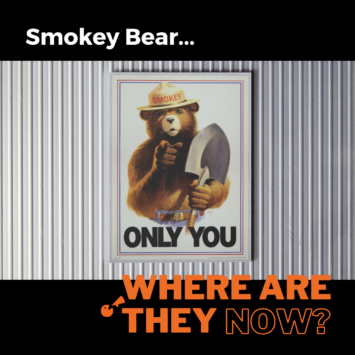
Smokey Bear. Where are they now?
This email series is a throwback to behavior change campaigns that ran on TV and in magazines when I was a kid. Enjoy the nostalgia of old ads and the thrill of discovering where they are now!
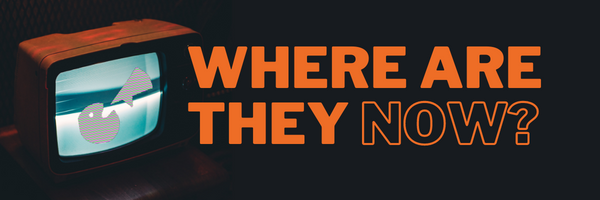
Smokey Bear.
Where are they now?
“Only YOU can prevent forest fires.”
I’m pretty sure we’re all familiar with this sentence and the furry, friendly, but finger-pointing bear who has said it for nearly 80 years.
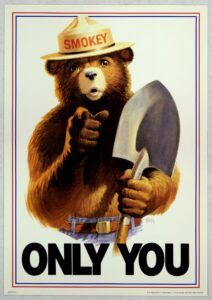
That’s right, I said 80 years!!!
Smokey Bear is the longest-running campaign we’ve dissected in this email series and is celebrated as being the longest-running public service advertising campaign in U.S. history, which means there is a lot of ground to cover.
Let’s dig in.
Smokey’s origin story.
The interest in developing a marketing campaign around preventing forest fires emerged during World War II.
At this time, there was a shortage of firefighters in the U.S., as many enlisted in the armed forces, and a growing fear that Japan was aiming to ignite wildfires by firing shells and launching fire balloons at Pacific Coast forests. Which meant forests were vulnerable. (History.com & SmokeyBear.com)
The U.S. Forest Service decided to jump on this moment of fear and patriotism to elevate the importance of forests and encourage Americans to prevent accidental forest fires.
They formed the Cooperative Forest Fire Prevention (CFFP) program with the newly created War Advertising Council (later the Ad Council) and the Association of State Foresters to launch a national campaign in 1942 with ad agency FCB. (History.com, SmokeyBear.com, Wikipedia)
Smokey Bear officially joined the campaign on August 9, 1944 (now considered Smokey’s birthday), and the first use of the slogan “Only you can prevent forest fires” appeared in 1947 on a set of Forest Services stamps. (SmokeyBear.com)
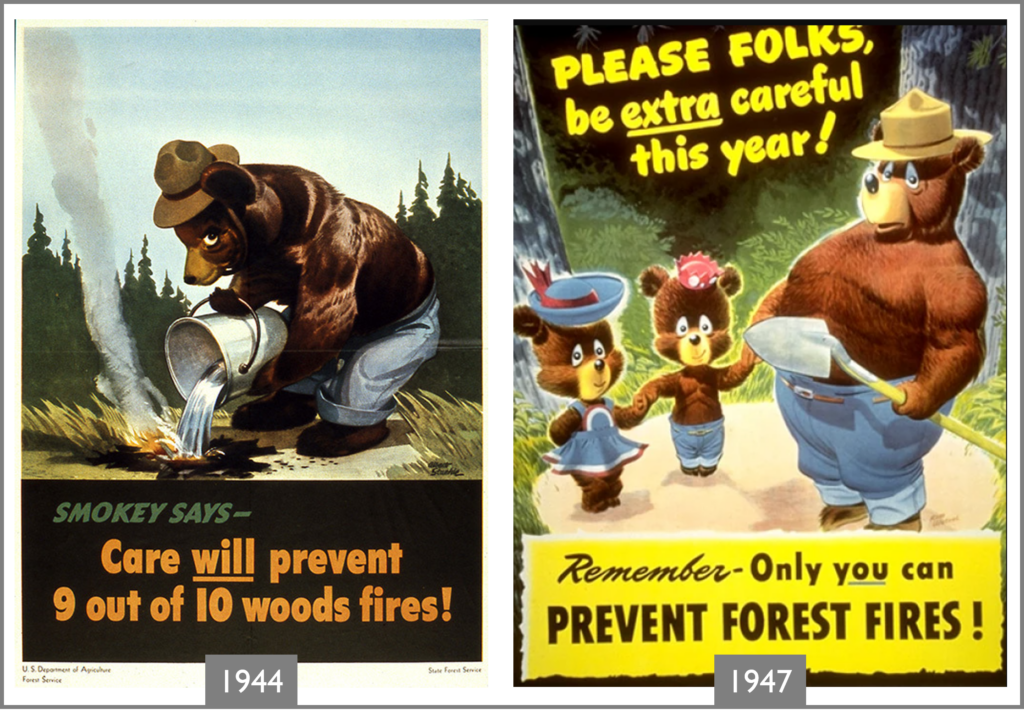
Five things I bet you didn’t know about this campaign.
1. The bear’s name is not Smokey the Bear, as I’ve called him my whole life. He is simply Smokey Bear. Most of the world gets this wrong thanks to a song written about him in 1952 that added the “the” to his name to improve the rhythm. (Smithsonian Magazine)
- Interestingly, the same songwriting team wrote the song “Frosty the Snowman.” Maybe HIS name is actually Frosty Snowman! We’ll never know!!!!
2. The original mascot was Bambi. It was an excellent fit for the campaign as Bambi was a beloved character who represented a healthy, happy forest. However, Disney only agreed to “loan” Bambi to the campaign for one year (1944), which pressured the CFFP to develop their own mascot. (SmokeyBear.com)
3. There was a real-life Smokey Bear at the National Zoo in Washington, D.C. Two of them, to be exact. Smokey was a black bear cub who barely survived a 1950 wildfire in New Mexico. Upon retirement, the zoo filled his role with another orphaned bear cub. (Wikipedia)
4. The slogan had three minor revisions over the years. The original slogan in 1947 was “Remember, only you can prevent forest fires,” but the agency dropped the “Remember” part in the 1960s to create the line we know best. In 2001, the CFFP updated it again to say “wildfires” instead of “forest fires” to encompass all types of wildfires that occur. (SmokeyBear.com)
5. Smokey Bear has his own ZIP code. Smokey received so many letters in the first two decades of the campaign that the U.S. Postal Service designated 20252 as his official ZIP code. If you’d like to send Smokey a letter or postcard, just address it to Smokey Bear, Washington, D.C. 20252. (USDA)
Through the years.
The same parties that developed the campaign in 1944 – the U.S. Forest Service, the National Association of State Foresters, the Ad Council, and FCB – continue to oversee the brand and its messages to this day.
Over eight decades, the campaign has remained essentially unchanged in its slogan, mascot, and focus on easy ways to prevent accidental fires.
Initially, the campaign promoted three behaviors: ensuring matches, campfires, and cigarettes were out and cold before leaving them behind. Today, the campaign covers burning yard waste, home equipment use, and – as always – campfire safety.
Here is a billboard journey through time, courtesy of a tribute to Smokey Bear by Clear Channel.
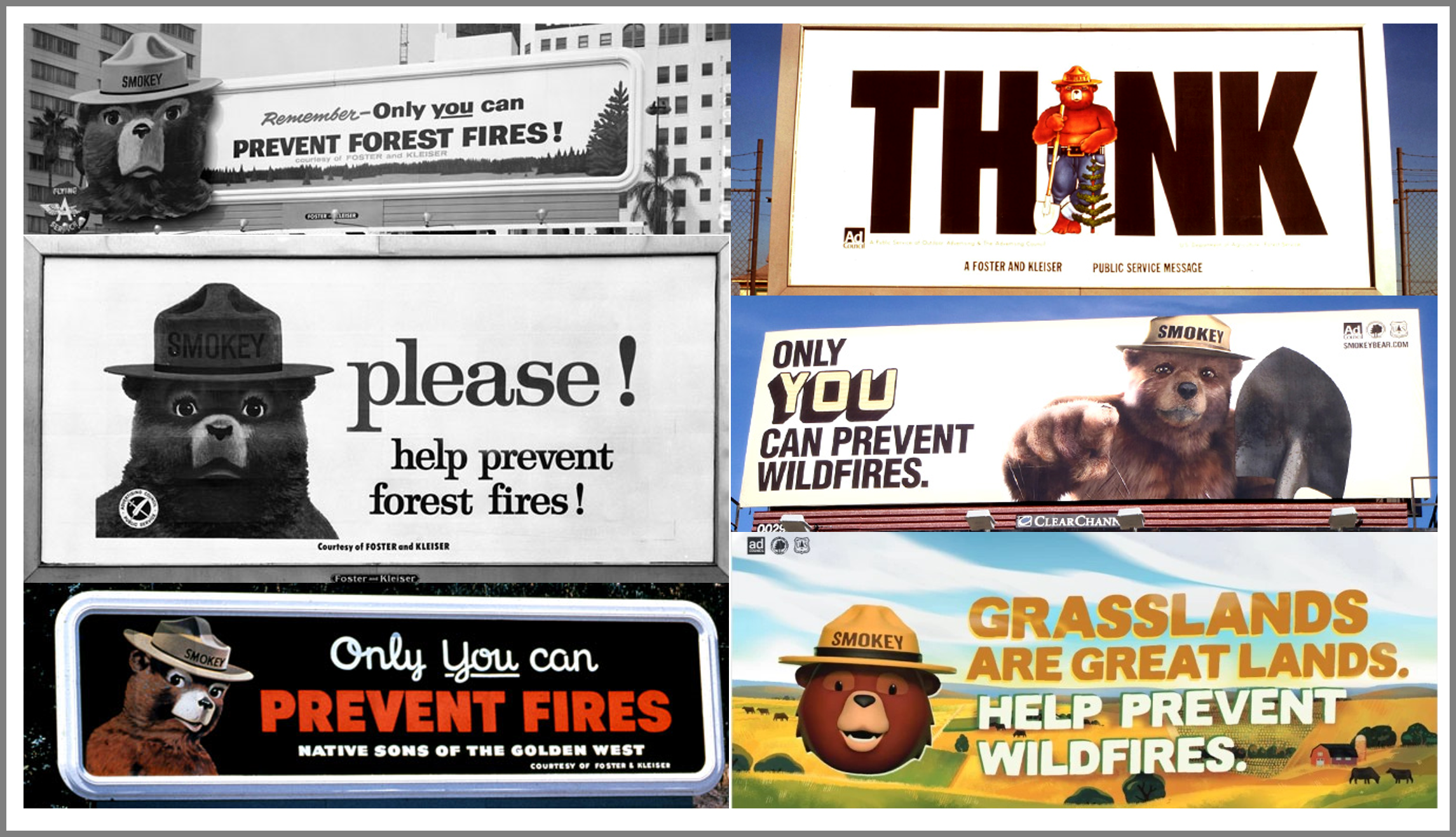
While the core message has remained the same, the campaign has undergone some evolutions in how it delivers the message.
Changing tones. The slogan leans heavily on the “responsibility” motivator, which they used consistently in the campaign. But over the decades, the creative concepts have explored adding a range of motivators from blame-and-shame to fun to validation.
These different tone approaches make for a few fascinating case studies on how advertising and PSA tones have changed over the years and which produce the best results. (If only this data exists – more on that later.)
Watch the short playlist below of 4 Smokey commercials using different tones over the years.
Smokey’s appearance. I suspect that when we all visualize Smokey Bear, we see a similar-looking brown bear wearing a ranger’s hat and blue jeans while holding a shovel.
Yet, visual depictions of Smokey changed in the 2010s and 2020s when he first became swole and then became an illustrated avatar. The avatar image is Smokey’s present-day look.
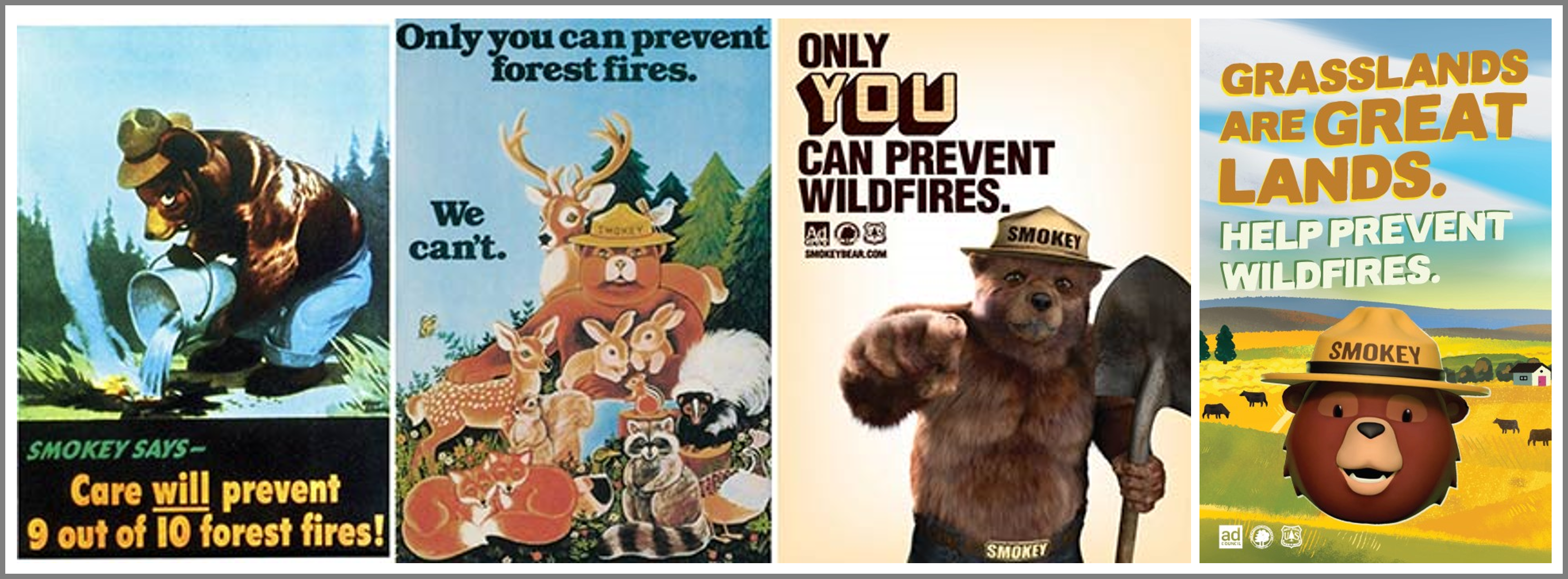
Where are they now?
The campaign’s most recent ads launched in 2022 focused on two core behaviors: extinguishing campfires and proper disposal of charcoals. Both ads feature a fictional Smokey phone “assistant” (like Siri and Alexa) describing proper fire prevention techniques.
While they are mainly informative, the ads utilize the motivators of fun and playfulness to keep the audience engaged.
To be honest, I’m surprised how little the campaign has addressed the growing severity of wildfires in the U.S.
I would have expected a shift in their messaging strategy to be more explicit about doing our collective part to prevent widespread fire events caused by human negligence and increasing the promotion of partner groups working on wildfire protection.
This feels like a missed opportunity to me.
Has the Smokey Bear campaign worked?
There are two popular responses to this question, yet both lack substantial evidence to support the claims.
Response 1: Smokey Bear as the G.O.A.T. (Greatest Of All Time)
There is no denying that Smokey Bear is extremely popular and recognizable. He even has a branded license plate and a balloon float in the Macy’s Thanksgiving Day parade.
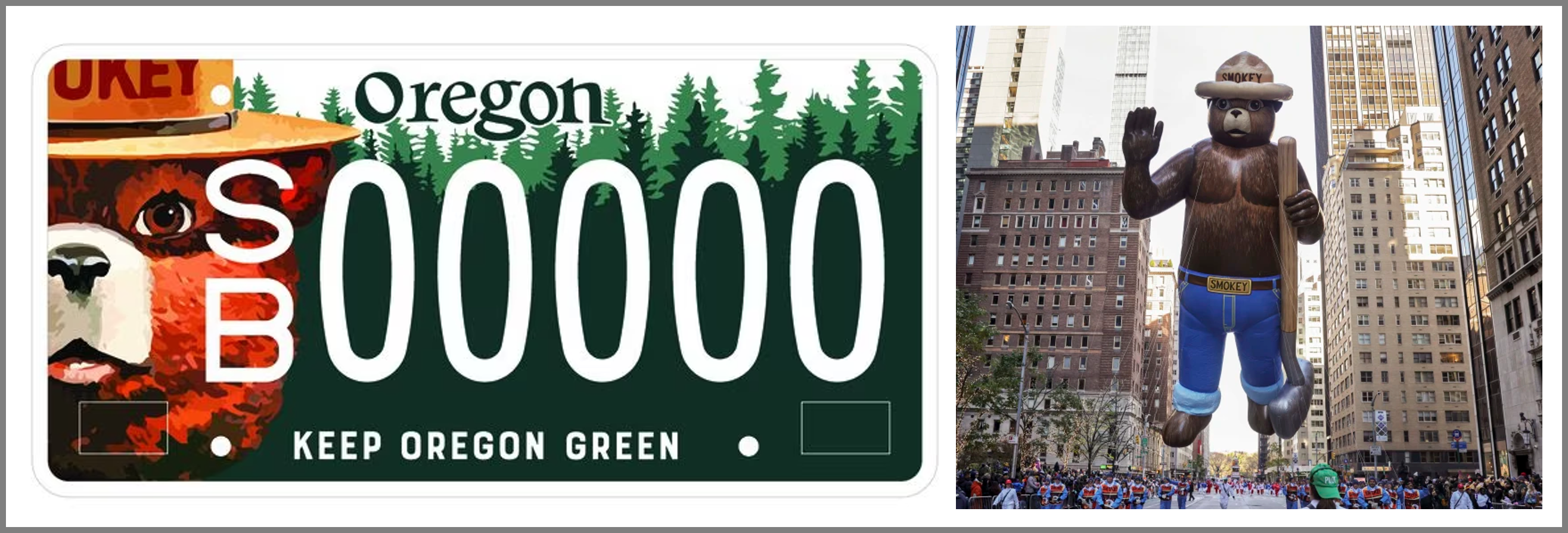
The Ad Council touts that over seven decades, “the campaign has received more than $1.4 billion in donated time and space from media companies. Awareness levels have also remained high, with 96 percent of the U.S. adult population recognizing Smokey Bear and 70 percent being able to recall Smokey’s tagline without any prompting.” (Ad Council Press Archives, 2014)
Many articles on the campaign celebrate it as one of the most successful PSA campaigns in American history.
The same Ad Council press announcement highlights that the “average number of acres lost annually to wildfire has decreased from 22 million in 1944 to an average of 6.7 million today [2014].” (The number of acres lost is higher today than in 2014 – Table 2).
Yet, none of these claims were cited or linked to reports I could view directly, and my web searches didn’t produce any. These impressive data points have been repeated in multiple articles I’ve linked throughout this blog, all linking back to the above press release, which does not contain details on the surveys conducted.
Being popular has benefits = merchandising, merchandising, merchandising! The Smokey Bear Act passed in 1952 protects the use of Smokey’s image and likeness under federal law, which opens the door for licensing (a.k.a. $$$). Licensees pay an application fee and royalties based on how much their Smokey Bear products earn.
Response 2: Smokey Bear as the scapegoat.
This response is where it gets intriguing and a bit murky. Some people claim the Smokey Bear campaign has contributed to the severity of wildfires.
In this article titled “Be careful what you wish for: the legacy of Smokey Bear,” the authors (both employees of the USDA Forest Service) kick off the paper with this bold statement:
For 60 years, Smokey Bear has successfully championed fire suppression in the United States, but his success has come at considerable cost. Indeed, it could be likened to the British victory over American rebels at Bunker Hill in 1775, about which it was said, “A few more such victories would surely spell ruin for the victors.”
(Although Smokey features prominently in the paper’s title, the authors only make three references to the character and campaign in the text.)
Tree ring expert Thomas Swetnam and historian Stephen Pyne add to the damage in this NPR interview.
Scars from thousands of [tree trunk] sections show how often fires burned in the Southwest. It was every five or 10 years, mostly — small fires that consumed grass and shrubs and small seedlings, but left the big Ponderosa pine and Douglas fir just fine. This was the norm.
Then something happened. “Around 1890 or 1900, it stops,” Swetnam says. “We call it the Smokey Bear effect.”
Settlers brought livestock that ate the grass, so fires had little fuel. Then when the U.S. Forest Service was formed, its marching orders were “no fires.” And it was the experts who approved the all-out ban on fires in the Southwest. They got it wrong.
(The Smokey campaign started in 1944, yet somehow the campaign influenced fire changes in 1890???)
The actual target of these accusations is the U.S. Forest Service’s policy of wildfire suppression, which for a long time didn’t allow the use of prescribed burns as a forest management tool. Over time, this has created more flammable forests. Yet, many of the arguments claim that Smokey’s campaign championed an “all fires are bad” mindset across America.
Now, I’m no forestry expert, so I can’t speak to the validity of the forest management arguments. However, I can call out the complete lack of data connecting Smokey’s popularity to Americans opposing the use of prescribed burns.
It almost feels like they are blaming Smokey for not doing someone else’s job, like doing public outreach on the benefits of prescribed burns.
Tough love takeaways.
There is much to learn from a campaign that has stood the test of time. Here are three tough love takeaways that kept coming to mind as I conducted this research.
1. Impact metrics are helpful. For a campaign that has been running for so long, it is surprising how little data, research, and analysis I could find on its effectiveness. Compare this to the previous case studies on D.A.R.E. and Don’t Mess with Texas, which conducted a lot of research and were evaluated by others.
Measuring brand recognition and recall is very important, and so is measuring results!!! Even if it’s hard to draw a correlation between the two, it’s valuable to learn when and where a strategic shift may be needed.
2. A well-known tagline won’t produce behavior change. We all know Smokey’s slogan because it’s everywhere in the campaign. But do you actually know the steps to take to prevent wildfires? If you said no, you’re not alone:
“Focus groups over the last four years say they recognize Smokey’s face and his name, and they can even hear his voice,” says Forman-Cook [communications director at the National Association of State Foresters]. “But they don’t really listen to him and they don’t know what they can do to prevent a wildfire.” (Nat Geo)
Although it’s a lot less sexy than repeating a well-known slogan, it’s essential to include a clear and specific action for your audience to take.
3. Popularity has its downside. Alternate title: Haters are going to hate. Most of us can only dream about creating a campaign mascot that reaches Smokey Bear status. But even average levels of visibility and popularity will attract haters who may claim that the campaign sucks or is causing more harm than good.
As your conservation movements gain traction, create a plan for how your organization plans to address potential backlash, even if the decision is to let it be.


